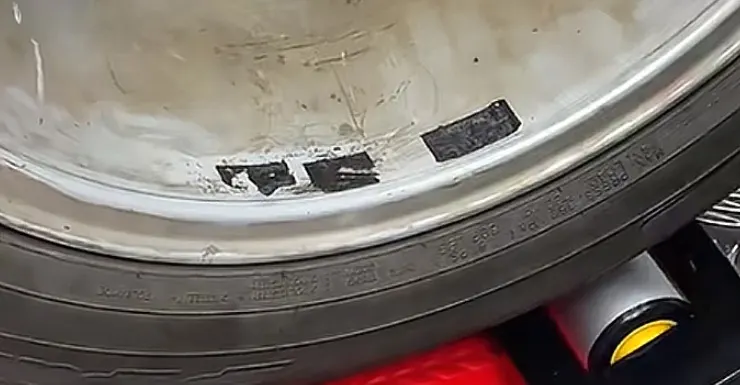Wheel weight adhesive remover
When removing adhesive from wheel weights on steel or alloy wheels, it’s essential to use safe, effective methods that won’t damage the wheel’s surface. Here’s a comprehensive guide to wheel weight adhesive removers, including products, techniques, and safety precautions:
1. Types of Adhesive Removers for Wheels
a. Commercial Adhesive Removers
- Goo Gone Automotive: Specifically designed for automotive surfaces, this solvent-based remover breaks down sticky residues without harming paint or clear coats.
- 3M Adhesive Remover: A popular choice for professionals, it efficiently dissolves strong adhesives (like those from wheel weights) and is safe for most wheel finishes.
- WD-40: While not a dedicated adhesive remover, WD-40 can loosen mild adhesive residues. It’s more suitable for light cleanup but may require multiple applications for tough spots.
- Isopropyl Alcohol (Rubbing Alcohol): Works for water-based adhesives or light residues. Apply with a cloth and rub gently; best for fresh, not dried-on adhesive.
b. Homemade Solutions
- Vinegar (White Distilled): Soak a cloth in warm vinegar and apply to the adhesive for 10–15 minutes to soften it. Suitable for mild residues on unpainted steel wheels.
- Peanut Butter or Vegetable Oil: The oil in peanut butter can break down adhesive over time. Apply, let sit for 30 minutes, then wipe off. This is a gentle option for painted or coated wheels.

2. Step-by-Step Removal Process
For Painted or Coated Wheels (Alloy or Steel)
- Prep the Wheel:
- Wash the wheel with soap and water to remove dirt or grime. Dry completely.
- Apply Adhesive Remover:
- Spray or apply the remover directly to the adhesive residue. For tough spots, let it sit for 5–10 minutes to penetrate.
- Gently Scrape Residue:
- Use a plastic scraper (never metal, which can scratch the wheel) to lift the softened adhesive. Work at a low angle to avoid damaging the surface.
- Wipe and Repeat:
- Wipe away the residue with a microfiber cloth. Repeat steps 2–3 if adhesive remains.
- Clean and Condition:
- After removal, wash the wheel again to remove remover residue. Apply a wheel protectant or wax to restore the finish.
For Unpainted Steel Wheels (Bare Metal)
- Rust Considerations: If the wheel has rust, address it after adhesive removal (e.g., with steel wool or a rust converter).
- Harsh Residues: For old, hardened adhesive on bare steel, a stronger solvent (like acetone or lacquer thinner) can be used, but test on a small area first to ensure it doesn’t damage the metal.
3. Safety and Wheel Protection Tips
- Avoid Harsh Chemicals on Finished Wheels:
- Never use acetone, paint thinner, or abrasive cleaners on painted, chrome-plated, or powder-coated wheels, as they can strip the finish.
- Protect Brake Components:
- Cover brake calipers and rotors with plastic sheeting to prevent remover from contacting them (some solvents can damage brake parts or reduce pad effectiveness).
- Ventilation:
- Use solvent-based removers in a well-ventilated area, and wear gloves to protect hands from chemicals.
- Test on a Small Area:
- Before applying any remover to the entire residue, test it on a small, inconspicuous part of the wheel to ensure compatibility with the finish.
4. Dealing with Stubborn Adhesive Residues
- Heat Application (for Tough Adhesives):
- Use a hairdryer on low heat to warm the adhesive, making it easier to peel or scrape. Avoid overheating, which can damage wheel coatings.
- Multiple Applications:
- For old, dried adhesive, apply remover, let it sit overnight, then try scraping again.
- Professional Help:
- If you’re unsure about the wheel’s finish or the adhesive is too stubborn, take the wheel to a tire shop or detailer. They have specialized tools and products for safe removal.
5. Preventing Adhesive Build-Up in the Future
- Regular Wheel Cleaning: Wash wheels regularly to prevent dirt and grime from bonding with adhesive residues.
- Choose the Right Weights: For steel wheels, consider clip-on weights instead of adhesive weights to minimize future residue issues.
- Inspect Weights: If weights fall off, remove any remaining adhesive promptly to prevent it from hardening.
Summary: Best Products and Methods
| Type of Remover | Effectiveness | Suitability | Caution |
|---|---|---|---|
| 3M Adhesive Remover | High | Painted, alloy, or steel wheels | Keep away from brake components; ventilate. |
| Goo Gone Automotive | High | Automotive surfaces, including wheels | Safe for most finishes; test on sensitive coatings. |
| Isopropyl Alcohol | Medium | Light residues, fresh adhesive | Less effective on old, tough glue; safe for most finishes. |
| Acetone (for bare steel) | High | Unpainted steel wheels only | Harsh; can damage paint or clear coats—avoid on finished wheels. |
By following these steps and using the right products, you can safely remove wheel weight adhesive without compromising the wheel’s integrity or finish. Always prioritize gentle methods first and escalate to stronger solutions only as needed.
